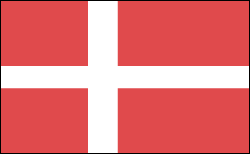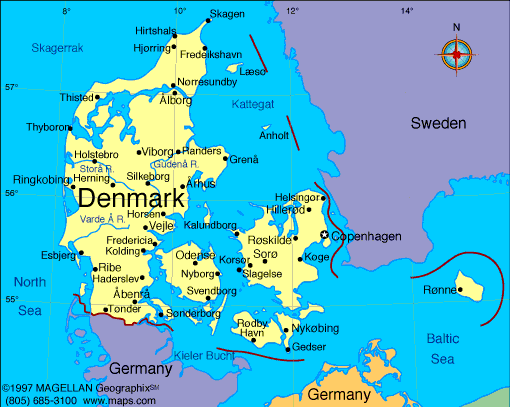DENMARK

Geography: Smallest of the Scandinavian countries (half the size of Maine), Denmark occupies the Jutland peninsula, a lowland area. The country also consists of several islands in the Baltic Sea; the two largest are Sjælland, the site of Copenhagen, and Fyn.
Government: Constitutional monarchy.
History: From 10,000 to 1500 B.C. , the population of present-day Denmark evolved from a society of hunters and fishers into one of farmers. Called Jutland by the end of the 8th century, its mariners were among the Vikings, or Norsemen, who raided western Europe and the British Isles from the 9th to 11th century.
The country was Christianized by Saint Ansgar and Harald Blaatand (Bluetooth)—the first Christian king—in the 10th century. Harald's son, Sweyn, conquered England in 1013. Sweyn's son, Canute the Great, who reigned from 1014 to 1035, united Denmark, England, and Norway under his rule; the southern tip of Sweden was part of Denmark until the 17th century. On Canute's death, civil war tore apart the country until Waldemar I (1157–1182) reestablished Danish hegemony in the north.
In 1282, the nobles won the Great Charter, and Eric V was forced to share power with parliament and a Council of Nobles. Waldemar IV (1340–1375) restored Danish power, checked only by the Hanseatic League of north German cities allied with ports from Holland to Poland. Denmark, Norway, and Sweden united under the rule of his daughter Margrethe in 1397. But Sweden later achieved autonomy and in 1523, under Gustavus I, independence.
Denmark supported Napoléon, for which it was punished at the Congress of Vienna in 1815 by the loss of Norway to Sweden. In 1864, the Prussians under Bismarck and the Austrians made war on Denmark as an initial step in the unification of Germany. Denmark was neutral in World War I.
Government: Constitutional monarchy.
History: From 10,000 to 1500 B.C. , the population of present-day Denmark evolved from a society of hunters and fishers into one of farmers. Called Jutland by the end of the 8th century, its mariners were among the Vikings, or Norsemen, who raided western Europe and the British Isles from the 9th to 11th century.
The country was Christianized by Saint Ansgar and Harald Blaatand (Bluetooth)—the first Christian king—in the 10th century. Harald's son, Sweyn, conquered England in 1013. Sweyn's son, Canute the Great, who reigned from 1014 to 1035, united Denmark, England, and Norway under his rule; the southern tip of Sweden was part of Denmark until the 17th century. On Canute's death, civil war tore apart the country until Waldemar I (1157–1182) reestablished Danish hegemony in the north.
In 1282, the nobles won the Great Charter, and Eric V was forced to share power with parliament and a Council of Nobles. Waldemar IV (1340–1375) restored Danish power, checked only by the Hanseatic League of north German cities allied with ports from Holland to Poland. Denmark, Norway, and Sweden united under the rule of his daughter Margrethe in 1397. But Sweden later achieved autonomy and in 1523, under Gustavus I, independence.
Denmark supported Napoléon, for which it was punished at the Congress of Vienna in 1815 by the loss of Norway to Sweden. In 1864, the Prussians under Bismarck and the Austrians made war on Denmark as an initial step in the unification of Germany. Denmark was neutral in World War I.

Map of Denmark
Sovereign: Queen Margrethe II (1972)
Prime Minister: Lars Lokke Rasmussen (2015)
Land area: 16,359 sq mi (42,370 sq km);
total area: 16,639 sq mi (43,094 sq km)1
Population (2014 est.): 5,569,077 (growth rate: 0.22%); birth rate: 10.22/1000;
infant mortality rate: 4.1/1000; life expectancy: 79.09
Capital and largest city (2011 est.):
Copenhagen, 1.206 million
Monetary unit: Krone
National
name: Kongeriget Danmark
Languages:
Danish, Faroese, Greenlandic (Inuit dialect),
German; English is the predominant second language
Ethnicity/race:
Scandinavian, Inuit, Faroese, German, Turkish,
Iranian, Somali
National Holiday:
Constitution Day, June 5
Religions:
Evangelical Lutheran (official) 80%, Muslim 4%, other
(denominations of less than 1% each, includes Roman Catholic, Jehovah's
Witness, Serbian Orthodox Christian, Jewish, Baptist, and Buddhist) 16%
(2012 est.)
Literacy
rate: 99%
Economic summary:
GDP/PPP (2013 est.): $211.3 billion; per capita $37,800.
Real growth rate: 0.1%. Inflation: 0.8%.
Unemployment: 6%. Arable land: 57.99%.
Agriculture: barley, wheat, potatoes, sugar beets; pork, dairy
products; fish. Labor force: 2.795 million; agriculture 2.6%,
industry 20.3%, services 77.1% (2013 est.). Industries: iron,
steel, nonferrous metals, chemicals, food processing, machinery and
transportation equipment, textiles and clothing, electronics,
construction, furniture and other wood products, shipbuilding and
refurbishment, windmills, pharmaceuticals, medical equipment.
Natural resources: petroleum, natural gas, fish, salt,
limestone, stone, gravel and sand. Exports: $106 billion (2013 est.): machinery and instruments, meat and meat products,
dairy products, fish, chemicals, furniture, ships, windmills.
Imports: $98.45 billion (2013 est.): machinery and
equipment, raw materials and semimanufactures for industry, chemicals,
grain and foodstuffs, consumer goods. Major trading partners:
Germany, Sweden, UK, U.S., Netherlands, Norway, China
(2012).
Communications: Telephones:
main lines in use: 2.431 million (2012); mobile cellular: 6.6 million (2012). Broadcast media:strong
public-sector television presence with state-owned Danmarks Radio (DR)
operating 4 channels and publicly-owned TV2 operating roughly a half
dozen channels; broadcasts of privately-owned stations are available
via satellite and cable feed; DR operates 4 nationwide FM radio
stations, 15 digital audio broadcasting stations, and about 15
web-based radio stations; approximately 250 commercial and community
radio stations are operational (2007). Internet hosts:4.297 million (2012). Internet
users: 4.75 million (2009).
Transportation: Railways: total: 2,667 km km
(2011). Highways: total: 73,197 km; paved: 73,197 km (includes 1,111 km of expressways) (2011). Waterways: 400 km (2010). Ports and harbors: Aalborg, Aarhus, Copenhagen, Ensted, Esbjerg, Fredericia, Kalundborg. Airports: 92 (2013
est.).
Transportation: Railways: total: 2,667 km km
(2012). Highways: total: 73,929 km; paved: 73,929 km (includes 1,143 km of expressways) (2012). Waterways: 400 km (2010). Ports and harbors: Aalborg, Aarhus, Copenhagen, Ensted, Esbjerg, Fredericia, Kalundborg. Airports: 80 (2010
est.).
International disputes:
Iceland, the UK, and Ireland dispute Denmark's claim that the Faroe
Islands' continental shelf extends beyond 200 nm; Faroese continue to
study proposals for full independence; sovereignty dispute with Canada
over Hans Island in the Kennedy Channel between Ellesmere Island and
Greenland; Denmark (Greenland) and Norway have made submissions to the
Commission on the Limits of the Continental shelf (CLCS) and Russia is
collecting additional data to augment its 2001 CLCS submission.
-------------------- o --------------------
No comments:
Post a Comment